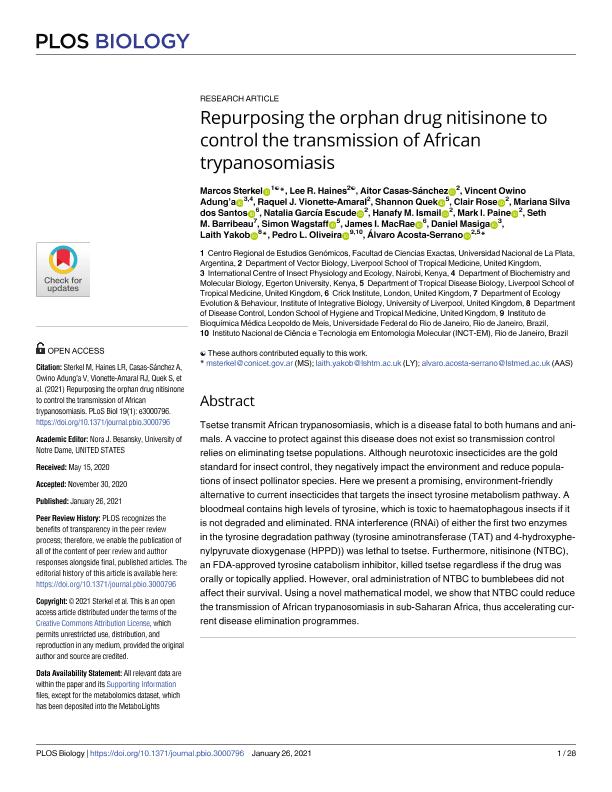Artículo
Tsetse transmit African trypanosomiasis, which is a disease fatal to both humans and animals. A vaccine to protect against this disease does not exist so transmission control relies on eliminating tsetse populations. Although neurotoxic insecticides are the gold standard for insect control, they negatively impact the environment and reduce populations of insect pollinator species. Here we present a promising, environment-friendly alternative to current insecticides that targets the insect tyrosine metabolism pathway. A bloodmeal contains high levels of tyrosine, which is toxic to haematophagous insects if it is not degraded and eliminated. RNA interference (RNAi) of either the first two enzymes in the tyrosine degradation pathway (tyrosine aminotransferase (TAT) and 4-hydroxyphe-nylpyruvate dioxygenase (HPPD)) was lethal to tsetse. Furthermore, nitisinone (NTBC), an FDA-approved tyrosine catabolism inhibitor, killed tsetse regardless if the drug was orally or topically applied. However, oral administration of NTBC to bumblebees did not affect their survival. Using a novel mathematical model, we show that NTBC could reduce the transmission of African trypanosomiasis in sub-Saharan Africa, thus accelerating current disease elimination programmes. Tsetse transmit African trypanosomiasis, which is a disease fatal to both humans and animals. A vaccine to protect against this disease does not exist so transmission control relies on eliminating tsetse populations. Although neurotoxic insecticides are the gold standard for insect control, they negatively impact the environment and reduce populations of insect pollinator species. Here we present a promising, environment-friendly alternative to current insecticides that targets the insect tyrosine metabolism pathway. A bloodmeal contains high levels of tyrosine, which is toxic to haematophagous insects if it is not degraded and eliminated. RNA interference (RNAi) of either the first two enzymes in the tyrosine degradation pathway (tyrosine aminotransferase (TAT) and 4-hydroxyphenylpyruvate dioxygenase (HPPD)) was lethal to tsetse. Furthermore, nitisinone (NTBC), an FDA-approved tyrosine catabolism inhibitor, killed tsetse regardless if the drug was orally or topically applied. However, oral administration of NTBC to bumblebees did not affect their survival. Using a novel mathematical model, we show that NTBC could reduce the transmission of African trypanosomiasis in sub-Saharan Africa, thus accelerating current disease elimination programmes.
Repurposing the orphan drug nitisinone to control the transmission of African trypanosomiasis
Sterkel, Marcos ; Haines, Lee R.; Casas Sánchez, Aitor; Adung'a, Vincent Owino; Vionette Amaral, Raquel J.; Quek, Shannon; Rose, Clair; dos Santos, Mariana Silva; Escude, Natalia García; Ismail, Hanafy M.; Paine, Mark I.; Barribeau, Seth M.; Wagstaff, Simon; MacRae, James I.; Masiga, Daniel; Yakob, Laith; Oliveira, Pedro L.; Acosta Serrano, Álvaro
; Haines, Lee R.; Casas Sánchez, Aitor; Adung'a, Vincent Owino; Vionette Amaral, Raquel J.; Quek, Shannon; Rose, Clair; dos Santos, Mariana Silva; Escude, Natalia García; Ismail, Hanafy M.; Paine, Mark I.; Barribeau, Seth M.; Wagstaff, Simon; MacRae, James I.; Masiga, Daniel; Yakob, Laith; Oliveira, Pedro L.; Acosta Serrano, Álvaro
 ; Haines, Lee R.; Casas Sánchez, Aitor; Adung'a, Vincent Owino; Vionette Amaral, Raquel J.; Quek, Shannon; Rose, Clair; dos Santos, Mariana Silva; Escude, Natalia García; Ismail, Hanafy M.; Paine, Mark I.; Barribeau, Seth M.; Wagstaff, Simon; MacRae, James I.; Masiga, Daniel; Yakob, Laith; Oliveira, Pedro L.; Acosta Serrano, Álvaro
; Haines, Lee R.; Casas Sánchez, Aitor; Adung'a, Vincent Owino; Vionette Amaral, Raquel J.; Quek, Shannon; Rose, Clair; dos Santos, Mariana Silva; Escude, Natalia García; Ismail, Hanafy M.; Paine, Mark I.; Barribeau, Seth M.; Wagstaff, Simon; MacRae, James I.; Masiga, Daniel; Yakob, Laith; Oliveira, Pedro L.; Acosta Serrano, Álvaro
Fecha de publicación:
01/2021
Editorial:
Public Library of Science
Revista:
PLoS Biology
ISSN:
1544-9173
Idioma:
Inglés
Tipo de recurso:
Artículo publicado
Clasificación temática:
Resumen
Archivos asociados
Licencia
Identificadores
Colecciones
Articulos(CCT - LA PLATA)
Articulos de CTRO.CIENTIFICO TECNOL.CONICET - LA PLATA
Articulos de CTRO.CIENTIFICO TECNOL.CONICET - LA PLATA
Citación
Sterkel, Marcos; Haines, Lee R.; Casas Sánchez, Aitor; Adung'a, Vincent Owino; Vionette Amaral, Raquel J.; et al.; Repurposing the orphan drug nitisinone to control the transmission of African trypanosomiasis; Public Library of Science; PLoS Biology; 19; 1; 1-2021; 1-28
Compartir
Altmétricas



